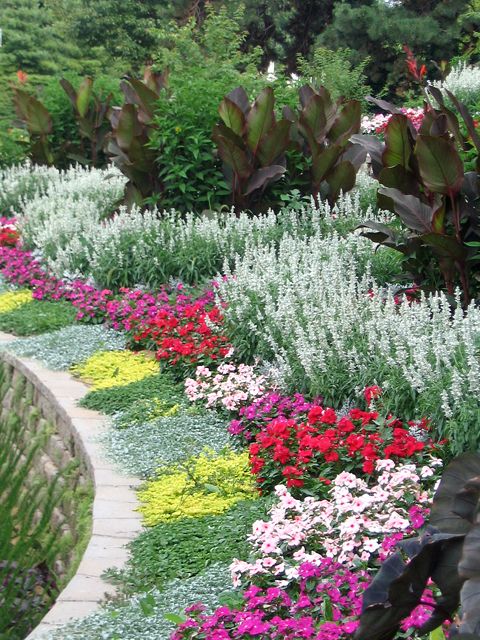Table Of Content

Softscape can include, flowers, plants, shrubs, trees, sod and flower beds. Drought-tolerant and desert landscaping are just two types we specialize in. Building a flower bed from scratch might seem intimidating, but it's a fairly straightforward project that just about any enthusiastic DIYer or gardener can accomplish. The time spent planning, designing, and preparing will be repaid once you have the time to admire your beautiful blooms. A good option for smaller plants and flowers, a spiral garden is a variation of a raised bed. "A spiral raised bed is a good option to maximize the space you have," says Raboine.
Narrow Side Yard Makeover!
While this is a more involved project than many other borders would be, it really has a beautiful, polished look. A little effort goes a long way here and creates a long-lasting element in your garden. There are lots of wonderful flowering plants that attract hummingbirds, even better than feeders can. My feeders always stay full while my porterweed is a veritable who’s who of pollinating critters. Some other hummingbird favorites include cuphea, fire spike, and all types of salvia.
12 Best Free Landscape Design Software for Architects in 2024 - G2
12 Best Free Landscape Design Software for Architects in 2024.
Posted: Mon, 04 Mar 2024 08:00:00 GMT [source]
Planting the Seedlings or Plants
A green-and-purple garden can attract butterflies and other beneficial insects to your flowers. Butterflies love pretty purple prairie flowers, making them more likely to frequent your garden when it’s in bloom. Add some brown mulch to help define the plants and enhance the overall appearance of the garden next to a stone walkway or sidewalk. Adding a birdhouse and bird bath to your flower bed is sure to bring colorful songbirds to your garden, but these fixtures can also give your outdoor space a special feel. This can be especially true if you seek out unusual birdhouses or baths that you can’t find just anywhere.
Ornamental Grass Plants for Landscaping and How To Use Them
For a harmonious look, opt for colors that will match the materials. Here, white flowers and the silvery foliage of Senecio 'Angel Wings' complement the surrounding pale tones, whilst Alchemilla mollis adds a refreshing splash of green. Plus, alchemilla looks beautiful when sparkling raindrops catch upon its leaves. In this show garden, the tall planters are packed with beautiful, bee-friendly choices, including helianthus, salvias, and asters. Our favorite flower choices in this scheme have to be the show-stopping echinacea – including a fiery orange variety – which complement the deep pink dahlias beautifully. We like the use of erigeron, too, with its delicate white blooms that will scramble over the edges as it grows.
Use jewel-like hues around water
Some of the top plants that attract butterflies include goldenrod, coneflowers, ironweed, lantana, and asters. If you’re serious about convincing butterflies to stick around, grow host plants where the insects can lay their eggs. Milkweed, violets, asters, and dill are host plant examples, but check with a local garden center to find the preferred flower varieties of your area’s butterfly species. If you have a sloped backyard, you may already have a retaining wall in place to prevent erosion.

Here, a colorful mix of plants has been chosen with a good variation of heights, providing a rich tapestry of texture and form. It does a wonderful job at softening the hardscaping and upping the sensory appeal of the space, and it will welcome lots of pollinators to the zone, too. One easy way to do this is by focusing on wall or garden fence color ideas and considering how they can be used to enhance your planting. For instance, this charcoal-colored fence allows the tonal-hued plants in front to really pop, and gives the scene a contemporary feel. Add some springtime cheer by planting flowers along the perimeter of a white picket fence. The bright pinks, yellows, and purples will stand out nicely against the backdrop of the fence.
Combine flowers with succulents
In this article, gardening expert Jill Drago will list 27 perennials that are perfect for your raised beds. Daily watering can be costly and time-consuming, as can frequently, replacing dying plants. But if you love to cook with fresh herbs, consider turning a flower bed into an herb bed. This is especially nice for beds that are close to outdoor living spaces and entryways.
Use flowers to border a decking area
Or perhaps you have a flower bed that you love, but you’d like to upgrade your edging or add some fun new elements to your garden space. To create a garden that offers year-round interest, select plants that bloom at different times throughout the seasons. Choose a mix of early bloomers, mid-season bloomers, and late bloomers to ensure that you have flowering plants at different times from spring to fall. You'll also want some evergreens included to add interest in the winter months.
In general, it is best to layer plants, with the tallest in the back and the shortest in front. Tall flowers like sunflowers also need plenty of space, so you may have room for only one or two. Upright trellised sweet peas or other annual vines can provide vertical accents just as tall flowers do. If you want to build a raised garden bed that will stand the test of time, brick is the way to go. "Brick may be one of the costliest materials to use for a raised bed, but will give a lasting, strong structure," says Sutton. "It will hold the soil in place but will need some maintenance if the mortar needs attention."
There's a new daytime show on the Hallmark channel called, "Home and Family" that received a front yard makeover by me! There's nothing more satisfying than designing a garden makeover for a deck when it's empty, like the one at the "Home & Family Show."... At the start of each month, get a roundup of upcoming plant-related activities and events in Southern California, along with links to tips and articles you may have missed.
Designing a flower bed from scratch also provides an opportunity to learn about different plant species, growth requirements, and aspects of design. So, if you love the look as much as we do, why not integrate it into your flower beds? It's great for container gardening ideas, as seen here, where tall planters house rows of glossy pink tulips.
Flower seeds and plug plants are very affordable, which makes them invaluable for covering larger areas in a space that's in need of TLC. Whether full of annuals or perennials, all in shades of blue and white or a glorious rainbow of colors, flowers delight the senses and add beauty to any yard, big or small. As you start slipping plants into place, consider the angles from which the garden will most often be viewed. Is there a visual backdrop behind the bed, or is it wide open space?
Well-shaped hedges of boxwood or yew make a wonderful foundation for a variety of well-cared-for perennial flowering plants, combining edibles and herbs with decorative florals. They also have all the benefits of raised bed gardening, allowing control over soil and watering conditions and containing plants that tend to spread quickly. If you have an incline to your space, terraced gardens are practical as well as attractive. Terraced garden beds can help prevent erosion and make use of space that you may not have considered a good garden spot. Larkspur makes a wonderful foundation, mingled with some salvia and long ornamental grasses. Smaller plants can get lost in the throng, so they should be placed strategically near the outer edges of the bed.

No comments:
Post a Comment